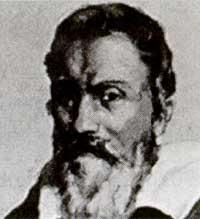Galileo
(1564-1642)
Italian physicist and astronomer born in Pisa on 15 February 1564, three days before the death of Michel-Angelo.

His name was Galileo Galilei, his father was a mathematician and he wanted to give another way of life to his son. He wanted to push his son down the path of medicine, as doctors earned thirty times more than mathematicians. But when Galileo was young, he heard a lecture on geometry and soon there arose the hobby of mathematics. His father was asked for permission to learn mathematics and science.
Galileo began to study physical phenomena and always tended to mathematically express the phenomenon. I wanted to explain phenomena in a simple way through numbers.
The first discovery was made at nineteen. When he was in the cathedral of Pisa, he saw the candle hanging. Then he went home and made two pendulums equal and showed that at the time of the oscillation the arc of slowness had nothing to do.
Galileo also invented a "termoscopio" to measure temperatures. This device was based on gas expansion and compression, but it was not very precise. In 1586 he published in a brochure a hydrostatic scale project.
Galileo also studied the fall of the bodies. He said that in the void all bodies fell at the same speed. They say that on the leaning tower of Pisa dropped two bodies, one light and one heavy. Both bodies came together to the ground.
Galileo showed that when the body falls in the inclined plane it moves with constant acceleration. On the other hand, he dealt with the parabolic trajectory of the shells and published a book on mechanics. There he established the first bases of material resistance.
Galileo had a special character. It was not nice to people. He treated with irony those who did not think like him and therefore had many enemies.
He moved to Padova where he related to astronomer Kepler. In 1609 he made 32 times the telescope and began to study the sky. He discovered that on the Moon there were mountains and that the Sun had spots. In addition, he saw that the sun revolved every 27 days around his axis. As seen with a telescope, Jupiter had four planets and all the stars did not revolve around the Earth.
Galileo traveled to Rome in 161 n and, years later, the Inquisition hit his theories for heresy. Galileo gave up the court, but at the end he died: "Eppur si muove" i.e., "however, it moves".
He had given that excellent teaching of scientific dignity when death came to him. In 1642 they are located in the town of Arcetri, in the area of Florence.
Buletina
Bidali zure helbide elektronikoa eta jaso asteroko buletina zure sarrera-ontzian











